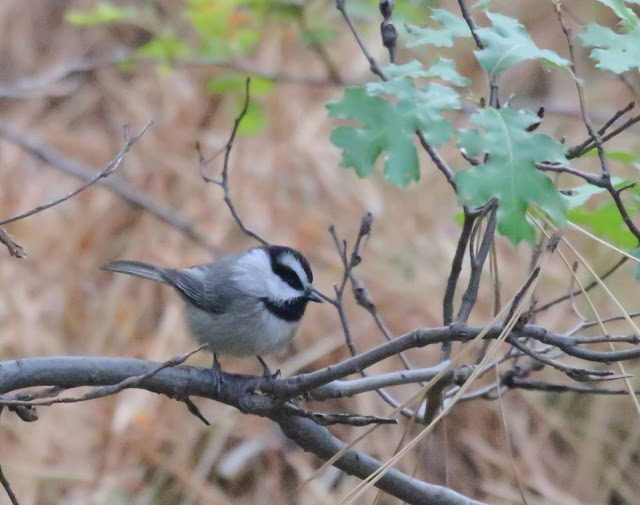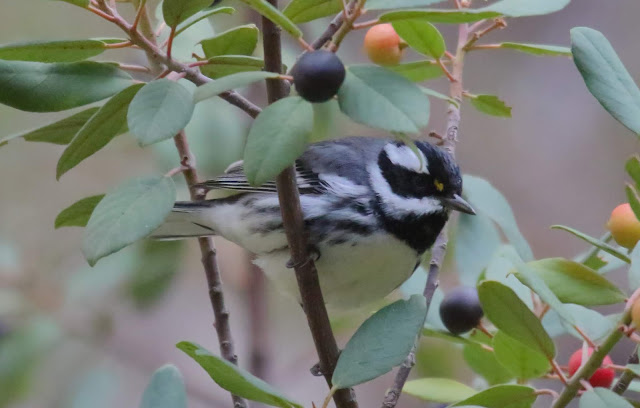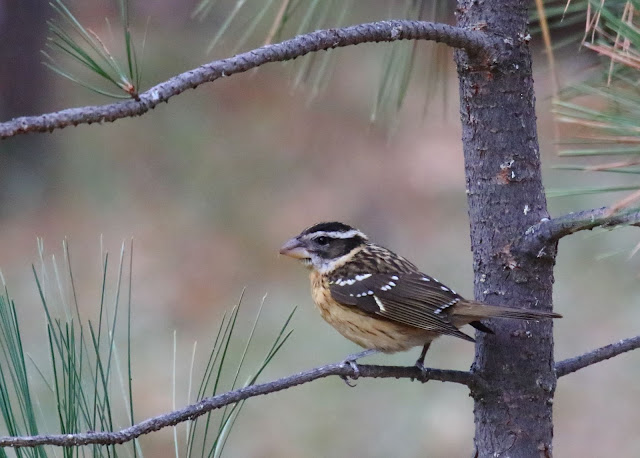The Laguna Mountains are the southernmost pine forests in San Diego County in the Descanso Ranger District of Cleveland National Forest. This location is easily accessed from San Diego on I-8, the interstate rising to over 5000 feet of elevation, less than 50 miles east from downtown.
To the north in San Diego County are the Cuyamaca Mountains, the thousands of acres of conifers of which were nearly completely incinerated in the 2003 Cedar Fire, except for a few remaining on Cuyamaca Peak (
site guide here) and at Stonewall Mine and Lake Cuyamaca (
site guide here). Farther north yet is Palomar Mountain (
site guide here).
The "town" here is Mount Laguna, population 57 in the 2010 census. The general store opens at 9:00 am.
There are many places to watch birds in this forest. The most well-known starting place is the roadside parking along Sunrise Highway (S1) at the meadow at
mile post 19 (A on Map 2). This is the starting point for snow play following rather rare winter storms. And there is forest hiking year-round.
In this site guide I describe Agua Dulce Creek. I visited in October 2018 intending on exploring for writing up this site guide, but not having specific information. Fortunately, I met Tuck Russell and after birding together to find rare Clark's Nutcrackers and Pinyon Jays, he showed me around Agua Dulce Creek.
There is rarely water flowing in the creek, except immediately after recent snows or rains. But there are a few "permanent" puddles, and willows and other streamside vegetation follow the ravine. There are fewer recreational hikers and riders (horse and bicycles) here than on other nearby trails.
The Laguna Mountain Volunteer Association has an excellent trail map/brochure, available at the Visitor's Information Center. Unfortunately, I couldn't find a pdf online. One downloadable tif version appears in the
Hiking Lady blog.
Getting there: From the I-15/I-8 interchange in San Diego, take I-8 38 miles east to Exit 47 to the Sunrise Hwy (S1). Continue about 8.5 miles to Wooded Hill Road (about mile post 21.7; B on Map 2 below). Drive in about one-half of mile. Pass by the Wooded Hill Group Camp and park in the Agua Dulce Equestrian Trailhead lot.
Parking: Adventure Pass required. Hours: Dawn to dusk.
Maps Navigation: Agua Dulce Trailhead, Wooded Hill Road, Mount Laguna, CA 91948.
Note: You must have an Adventure Pass to park in most areas here. A day pass on my visit in October 2018 was available for $5 at Mount Laguna store (Friday-Sunday, but doesn't open until 9:00 am). Adventure Passes are sold at outdoor stores, specifically, in the San Diego area: Big 5 Sporting Goods (
Adventure Pass Vendor list).
 |
| Map 1 |
 |
| Map 2. A is mile post 19 and immediate trails. B is Wooded Hill Rd. |
Where to bird: Hike the narrow, but well-defined, dirt trail (rut) east from the Equestrian Trailhead parking lot (P on Map 3). This leads
down to a meadow. The trail turns north (photo below). Follow the trail
down the narrow valley until the creek forms. The hiking is moderately difficult (not strenuous) with a definite elevation change.
At a small pumphouse (X on Map 3), take the trail across the creek. Turn back south for a hundred feet or so on the other side of the now-formed creek. This is where you are most likely to find some pools of water with birds coming in to drink. Then turn around and follow the trail along the east side of the creek,
down to the north. Soon the trail joins a dirt road alongside the creek. After a half mile the road splits (Y on Map 3). The left hand fork follows the creek, but you may choose to turn around any time. Tuck and I went another 1/4 mile or so on our visit, just before the trail reaches the edge of Laguna Meadow.
To return, follow your steps, now
up to the south!
 |
| Map 3. |
 |
| A little meadow just east of the parking area looking north. Follow the trail down the valley to the creek. |
 |
| The trail crosses Agua Dulce Creek at the little pumphouse; X on Map 3. |
 |
| Agua Dulce Creek. Typical Jeffery Pine and "creek side" habitat. |
 |
| Agua Dulce Creek. Lower trail opening up into Black Oaks. |
What kind of birds should you expect here?
Resident birds include Mountain Quail (most often detected in spring when calling), Band-tailed Pigeon, Red-tailed Hawk, Acorn Woodpecker, Nuttall's Woodpecker, Northern Flicker, Steller's Jay, California Scrub-Jay, Common Raven, Mountain Chickadee, Oak Titmouse, White-breasted Nuthatch, Pygmy Nuthatch, Brown Creeper (secretive), House Wren, Western Bluebird, Purple Finch, Dark-eyed (Oregon) Junco, Spotted Towhee.
Summer birds include Mourning Dove, Anna's Hummingbird, Turkey Vulture, Olive-sided Flycatcher, Western Wood-Pewee, Pacific-slope Flycatcher, Ash-throated Flycatcher, Cassin's Vireo, Violet-green Swallow, Bushtit, American Robin, House Finch, Lesser Goldfinch, Lawrence's Goldfinch, Chipping Sparrow, Lark Sparrow, California Towhee, Orange-crowned Warbler, Western Tanager, Black-headed Grosbeak.
Winter visitors include Williamson's Sapsucker (rare), Red-naped Sapsucker (rare), Golden-crowned Kinglet (rare), Ruby-crowned Kinglet, Hermit Thrush, Cassin's Finch (rare), Dark-eyed (Gray-headed) Junco (rare), White-crowned Sparrow, Golden-crowned Sparrow (rare).
Spring (late April and May) and especially fall migration (late August through October) are the key times to visit. You will see resident birds and perhaps some of the longer-staying summering or wintering birds. Regular migrants include: Rufous Hummingbird, Sharp-shinned Hawk (fall), Cooper's Hawk (fall), Red-shouldered Hawk (fall), Western Kingbird (spring), Hammond's Flycatcher, Warbling Vireo, Swainson's Thrush, Lincoln's Sparrow, Fox Sparrow (fall, Slaty-backed and Sooty), Nashville Warbler (fall), MacGillivray's Warbler, Yellow Warbler, Black-throated Gray Warbler, Townsend's Warbler, Hermit Warbler, Wilson's Warbler, Lazuli Bunting (rare).
Rare birds (mostly birds near the edge of their normal range) will be attracted to the water during migration--especially in fall, when other sources of water are hard to find. Conifer cones ripen in fall and early winter and may attract other rarities. Some rare birds may winter. Some rare birds have been found in summer. Rarities here have included: Northern Saw-whet Owl (resident calling in spring and summer), Dusky Flycatcher (spring), Willow Flycatcher (spring/fall), Plumbeous Vireo (fall), Clark's Nutcracker (fall), Red-breasted Nuthatch (year-round), Pacific Wren (spring), Blue-gray Gnatcatcher (summer), Townsend's Solitaire (fall), Varied Thrush (fall), Red Crossbill (fall), Pine Siskin (spring), Green-tailed Towhee (fall), Painted Redstart (summer), Hepatic Tanager (summer), Indigo Bunting (summer).
Here is an
eBird weekly frequency bar chart of birds at this location.
And a selection of bird photos from my recent trip on October 7, 2018:
 |
| Mountain Chickadee |
 |
| Acorn Woodpecker |
 |
| Steller's Jay |
 |
| Hairy Woodpecker |
 |
| Wilson's Warbler |
 |
| Hermit Thrush |
 |
| Green-tailed Towhee |
 |
| Brown Creeper |
 |
| Ruby-crowned Kinglet |
 |
| Black-throated Gray Warbler |
 |
| Black-headed Grosbeak |



















No comments:
Post a Comment
I really want to hear from you! I've changed settings (again) in order to try to make commenting easier without opening it up to spammers. Please note, however, that comments to posts older than 14 days will be moderated. Thank you.